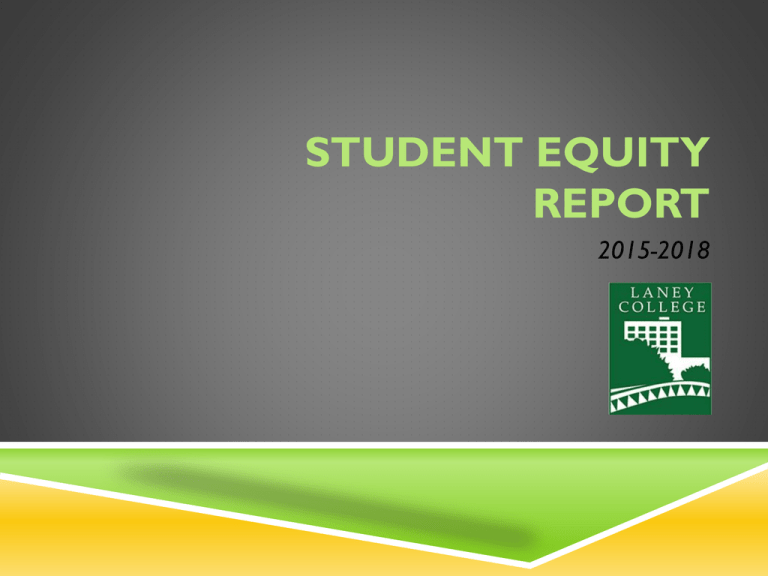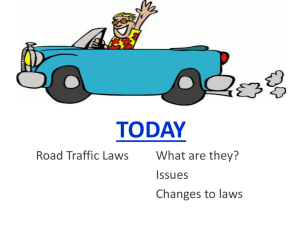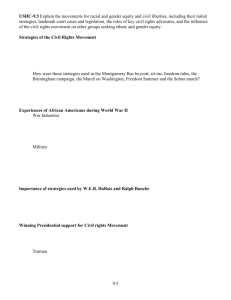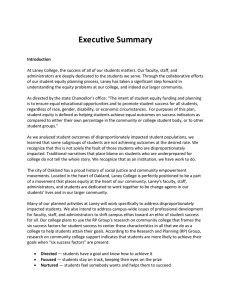Laney Board Presentation- Student Equity 12 9 14-2
advertisement

STUDENT EQUITY REPORT 2015-2018 LANEY COLLEGE CAMPUS BASED RESEARCH Disproportionate Impact Study regarding critical equity issues for our College. Access Comparing service area to Laney College community composition Course Completion ESL/Basic Skills Degree Applicable Course Completion Degree & Certificate Completion Transfer to a Four Year University Access In many cases the College serves the community varied demographics at higher rates than are present in the community. The College is underserving White students by 15% however. The College is also underserving 35-55 year olds College Feeder High School Data English Language Learners represent approximately 20% of feeder High School Students High school drop out rates are above 40% for American Indians, followed by Hispanic and African American students at approximately 26%. Additional data on foster youth and veteran students is needed Course Completion Course completion rates are the lowest for 19-24 year olds at 62% with the highest completion rates for students 35-54 year olds at above 70%. Course completion rates for American Indian and African American students is in the low 50 percentile indicating disproportionate impact. White and Asian students course completion rates are in the mid to high in the 70 percentile. ESL & Basic Skills Completion Younger students are more successful in ESL courses with a 45% success rate followed by 20-49 years of age 25% success rage. Students over the age of 50 drop to a 7% success rate. Both Males and Females complete Basic Skills courses at approximately the same rate- 25% in English & 29% in math. 16% of African American students are successful in English courses whereas 43% of Asian students are successful. DSPS students complete English courses at 18% versus non-DSPS students at 25% African American and Asian/Pacific Islander students have the lowest math success rates at 18% and 13% respectively. Degree and Certificate Completion Females have a slightly higher degree and completion rate of 15% to males at 13%. 30-34 year olds have the highest degree and completion rate at 25%. African American and Hispanic students represent the lowest degree and completion attainment rates at 13% followed by White students at 14%. Transfer to a Four Year College 40% of transfer students attend a CSU versus 31% who attend a UC. 21% of 15-17 year olds successfully completed a course after transfer followed by 19% of 18-19 year olds and 15% of 22-24 year olds. Data shows as ages increase successful completion of a transfer course decreases. Asian students successfully complete transfer courses at 34% followed by African American students at 20%. Only 9% of Hispanic/Latino students successfully complete a course after transfer indicating disproportionate impact Additional Research Needs Qualitative Data regarding all student groups: Focus Groups & Surveys with special focus on Foster Youth student Data Veteran student Data Re-entry Adult student Data Common Goals & Activities To Improve Equity SSSP Early Alert Program- Implement Early Alert System to support at risk students at critical points leading to increased course, degree and certificate completion and student success. Enhanced Tutoring Program- Develop and implement high level tutoring program hiring and training instructional assistants to improve current peer tutoring program across all disciplines. Culturally Relevant Learning Communities- Develop and Implement after conducting research on best practices with proven outcomes. Develop large scale program. Professional Development- Faculty and Staff development Social Justice Series- processing personal biases to better support and empower transformation and leadership in students. DSPS series-working with disabled individuals and different learning modalities. Common Goals & Activities To Improve Equity High School Transition Team- develop and implement team and plan designed for targeted outreach and relationship building with feeder schools. Multi-language marketing materials- Develop marketing materials and web page interfaces to meet community needs. Enhanced Communication and Collaboration- Intensify focus on communication and collaboration between student services and instruction- across the college. Develop Community and Civic Engagement Center- focused on service learning, peer-to-peer mentoring and community engagement activities and programs. Hire Diverse Faculty and Staff- Increase diversity at the college to mirror student community. STUDENT EQUITY PLANNING AGENDA BUDGET DETAIL The below amounts reflect projected salary and benefits per position Position/Activity Budget College Institutional Researcher 1.0 FTE 120,000. Student Equity/Outreach Coordinator 1.0 FTE 100,000. Web Master Equity Public Information Officer Instructional Assistant Level Tutors 80,000. 80,000. 60,000. Welcome Center Staff Network Technician- Instructional Labs 1.0FTE 60,000. 60,000. Community and Civic Engagement Center 50,000. Teaching and Learning Center 50,000. Learning Community Support Faculty Innovation Funding 100,000. 50,000. Faculty and Staff Professional Development Total 30,000. 840,000. Laney College~ Access, Equity & Success Meeting the holistic needs of our service community by providing educational and career skill building opportunities to reach life goals.



